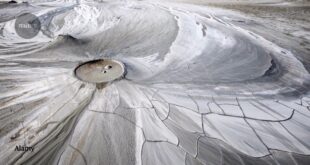GS-1
TSUNAMI WARNINGS ISSUED IN NEW ZEALAND
The National Emergency Management Agency highlighted that; New Zealand has issued a Tsunami warning in the coastal areas on March 4, 2021 following an earthquake of magnitude 8.0 in the north-eastern coast of the country in the Kermadec Islands region.
Highlights
- This was the third earthquake that struck the north-eastern area of the country, following a 7.4 magnitude earthquake in the same region.
- The country also witnessed a 7.2 magnitude earthquake which was about 900 kilometres away towards east of North Island.
- Following the tsunami warnings, people near the East Coast of the North Island, from the Matata to Tolaga Bay, Whakatane&Opotiki, from Bay of Islands to Whangarei and the Great Barrier Island have been asked to move immediately to high ground. This, the tsunami prone zones have been evacuated.
Threat Level
- National Emergency Management Agency in the latest update mentioned that, the GNS Science has reported that the largest waves have now passed.
- Thus, the threat level has now downgraded to the Beach and Marine threat for all areas that were under Land and Marine threat.
Areas which are still under threat
- The areas that are still under the Beach and Marine Threat are, North Cape from AHIPARA to Bay of Islands;
- Great Barrier Island, Chatham Island, East Coast of North Island from the Cape Runaway to Tolaga Bay.
Great Barrier Island
- The island is situated in the outer Hauraki Gulf, New Zealand.
- It is located at a distance of 100 kilometres from the north-east of central Auckland.
- It has an area of 285 square kilometres.
- The island is the sixth-largest island of New Zealand.
- The highest point on the island is Mount Hobson. It is 627 metres above sea level.
Tolaga Bay
- It is a bay as well as a small town to the East Coast of North Island in New Zealand.
- The region around the bay is rugged and remote.
- For many years, it was accessible by boat. It is a popular holiday spot.
Tsunami and Its Causes
- Tsunami meaning “harbour wave” in literal translation comes from the Japanese characters for harbour ( tsu ) and wave ( name ).
- A tsunami also called seismic sea waves, is one of the most powerful and destructive natural forces.
- It is a series of extremely long waves caused by a large and sudden displacement of the ocean due to earthquake, volcanic eruptions etc.
- When they reach the coast, they can cause dangerous coastal flooding and powerful currents that can last for several hours or days.
Global distribution of Tsunami
- Globally, 70% of the confirmed tsunami sources have been in the Pacific Ocean, 9% in the Caribbean Sea, 15% in the Mediterranean Sea and the Atlantic Ocean and 6% Indian Ocean.
- Most of these Tsunamis were generated by earthquakes.
- Tsunamis are frequently observed along the Pacific ring of fire, particularly along the coast of Alaska, Philippines, Japan and other islands of South Asia and Southeast Asia including Malaysia, Indonesia, Myanmar, Sri Lanka and India etc
Characteristics of Tsunami
- Tsunamis are among Earth’s most infrequent hazards and most of them are small and nondestructive
- Tsunamis generally consist of a series of waves, with periods ranging from minutes to hours
- Tsunamis radiate in all directions from the point of origin and they can cover entire ocean basins.
- There is no season for tsunamis. We cannot predict where, when or how destructive the next tsunami will be.
- Not all tsunamis act the same. And, an individual tsunami may impact coasts differently. A small tsunami in one place may be very large a few miles away.
- Most tsunamis are caused by large earthquakes. Though, not all earthquakes cause tsunamis.
- Tsunamis are waves generated by the tremors and not by an earthquake itself.
- The effect of Tsunami would occur only if the epicentre of the tremor is below oceanic waters and the magnitude is sufficiently high.
- A tsunami can strike any ocean coast at any time. They pose a major threat to coastal communities.
- The speed of the wave in the ocean depends upon the depth of water. It is more in the shallow water than in the ocean deep. As a result of this, the impact of a tsunami is more near the coast and less over the ocean
- Over deep water, the tsunami has very long wavelengths (often hundreds of kilometres long) when a tsunami enters shallow water, its wave-length gets reduced and the period remains unchanged, which increases the wave height.
- Tsunamis have a small amplitude (wave height) offshore. This can range from few centimetres to over 30 m height. However, most tsunamis have less than 3 m wave height.
How is a tsunami different from a wind-generated wave?
- Most ocean waves are generated by wind.
- Tsunamis are not the same as wind waves.
- First of all, they have different sources.
- Also while wind waves only affect the ocean surface, tsunamis move through the entire water column, from the ocean surface to the ocean floor.
- Waves can also be described based on their wavelength (horizontal distance between wave crests), period (time between wave crests), and speed.
- These characteristics highlight the differences between wind waves and tsunamis.
Causes of Tsunami
- A tsunami is caused by a large and sudden displacement of the ocean.
- Large earthquakes below or near the ocean floor are the most common cause.
- But landslides, volcanic activity, near earth objects (e.g., asteroids, comets), certain meteorological conditions and nuclear tests can also cause tsunamis.
Effects of Tsunami
- After the tsunamis reach the coast, an enormous energy stored in them is released which causes colossal loss of lives as well as the infrastructure of the place. As the port cities are economic hubs and densely populated the damage caused by the tsunami is devastating.
- The Tusanami of 2004 in the Indian Ocean is one of the devastating natural disasters in the modern time. It took a toll of nearly 230000 people leaving in the coasts of Indian Ocean.
- Unfortunately escaping a tsunami is nearly impossible. Hundreds and thousands of people are killed by tsunamis, most commonly by drowning, electrocution, explosions from gas and collapsing of buildings etc.
- Flooding and contamination of drinking water can cause disease such as Malaria to spread in the tsunami-hit areas.
- Tsunamis not only destroy human life, but also have a devastating effect on animal and plant life and other natural resources. A tsunami changes the landscape. It uproots trees and plants and destroys animal habitats.
- Contamination of soil and water is the second key environmental impact of a tsunami.
- There may be nuclear pollution due to radiation resulting from damaged nuclear plants, as it happened in Fukushima, Japan in March 2011.
- Tsunamis are extremely dangerous to coastal life and coastal property. They produce unusually strong currents, rapidly flooding the land and causing great damage to coastal property and life.
- The flow and force of the water and the debris it carries can destroy boats, vehicles, and buildings and other structures as the tsunami moves across the land.
- Victims of tsunami events often suffer psychological problems such as PTSD (Post Traumatic Stress Disorder) which can last for days, years or an entire lifetime.
- Massive economic costs hit communities and nations when a tsunami happens., severely affecting the economy of the nation.
- Poor nations are more prone to large-scale destruction as the infrastructure are not well developed, and warning systems are not robust or unavailable. Also, their ability to cope with such massive disaster remains inadequate.
- The water can be just as threatening (if not more so) as it returns to the sea, taking debris and people with it. Flooding and dangerous currents can last for days.
Tsunami Early Warning System
- Tsunami is the most unpredictable natural disaster in the world and to prevent the Tsunami is next to impossible. Hence, the only way to effectively mitigate the impact of a tsunami is through an early warning system.
- Tsunamis are detected in advance using a tsunami warning system (TWS) and early warnings are issued to safeguard the life of people. It is made up of two equally important components: a network of sensors to detect tsunamis and a communications infrastructure to issue timely alarms to permit evacuation of the coastal areas.
- There are many regional and international early warning systems installed all across the globe. National governments warn citizens through a variety of means, including SMS messages, radio and television broadcasts, and sirens from dedicated platforms, mosque loudspeakers and police vehicles with loudspeakers.
- India had volunteered to join the International Tsunami Warning System after the December 2004 tsunami disaster. The Indian Tsunami Early Warning Centre (ITEWC) embedded with specific systems called Deep Ocean Assessment and Reporting of Tsunamis (DART), established in 2007 at Indian National Centre for Ocean Information Sciences, (INCOIS – ESSO) Hyderabad, autonomous body under Ministry of Earth Sciences, is up and running to provide tsunami advisories for the events occurring in the global oceans.
- It has been recognized as one of the best systems in the world. The ITEWC includes a real-time seismic monitoring network of seventeen broadband seismic stations to detect tsunamigenic earthquakes and to provide timely warnings to the vulnerable community. It also receives earthquake data from all other global networks to detect earthquakes (of M6.5).
- Since its inception in October 2007, so far ITEWC has monitored 339 earthquakes of M 6.5. ITEWC also acts as one of the Regional Tsunami advisory Service Provider (RTSP) along with Australia & Indonesia for the Indian Ocean region.
Way forward and recommendation
- 2004 Indian Ocean Tsunami was a brutal reminder of disaster preparedness in India. While the current early warning system in India is state of the art, it is still inadequate in terms of preparedness for Tsunami. Following suggestions can be observed for enhancing India s preparedness for future Tsunami events:-
- Adopting integrated multi-hazard approach with emphasis on cyclone and tsunami risk mitigation in coastal areas
- Strict implementation of the coastal zone regulations
- Plantation of mangroves and coastal forests along the coastline
- Identification of vulnerable structures and appropriate retrofitting for tsunami resistance of all such buildings as well as appropriate planning, designing, construction of new facilities
- Capacity building programmes and public awareness campaigns should be held at Tsunami prone areas
- Streamlining the relief distribution system and evacuation plans in Tsunami prone areas
- Component of planning for reconstruction and rehabilitation should be added to disaster management plans at all levels
- Emphasis on mental health and to socio-psychological issues during post-disaster period should be accorded in every plan
SOURCE:MINT,DTE
 Chinmaya IAS Academy – Current Affairs Chinmaya IAS Academy – Current Affairs
Chinmaya IAS Academy – Current Affairs Chinmaya IAS Academy – Current Affairs



